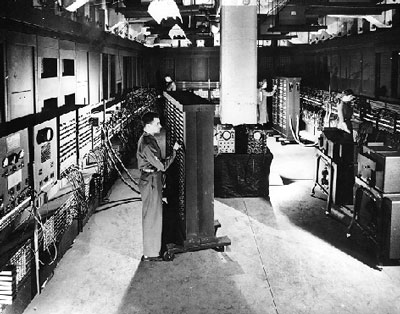
 |
Search | FAQ | US Titles | UK Titles | Memories | VaporWare | Digest | |||||||
| GuestBook | Classified | Chat | Products | Featured | Technical | Museum | ||||||||
| Downloads | Production | Fanfares | Music | Misc | Related | Contact | ||||||||
| CED in the History of Media Technology | ||||||||||||||

ENIAC (Electrical Numerical Integrator And Calculator) was originally developed during Word War II to perform complex trajectory calculations for artillary, but the war ended before the machine was operational. But it continued to be used after the war, performing calculations for the design of the hydrogen bomb, weather prediction, cosmic-ray analysis, thermal ignition, random numbers, and wind-tunnel design. The ENIAC contained 17,468 vacuum tubes, along with 70,000 resistors, 10,000 capacitors, 1,500 relays, 6,000 manual switches and 5 million soldered joints. It covered 1,800 square feet of floor space, weighed 30 tons, and consumed 160,000 Watts of electrical power, making the lights go dim in Philadelphia each time it was powered up. On October 2, 1955 the ENIAC was shut down for the last time, but by then inventors John Mauchly and John Presper Eckert had already had the UNIVAC computer on the market for several years.